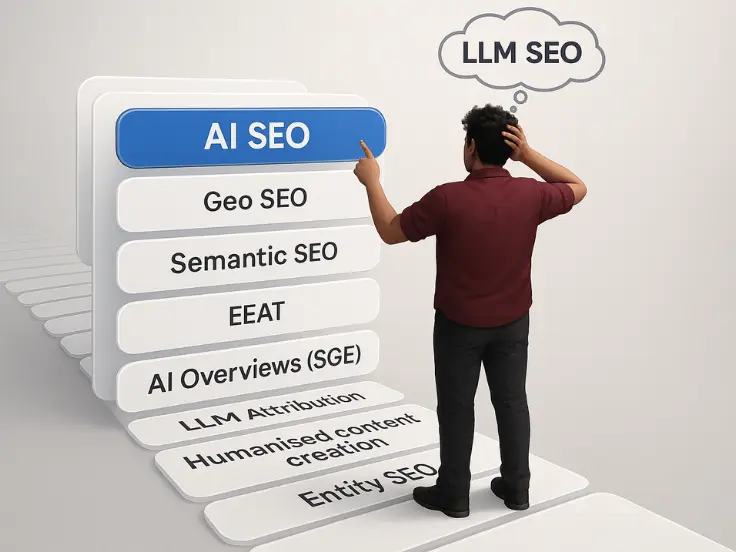In 2025, many marketers are asking how do I format glossary pages to maximize LLM citations? The answer lies in clear structure, schema markup, and natural language definitions. Let’s Explore the Glossary first.
1. LLM SEO
What it means: Optimizing your content so that AI tools like ChatGPT, Gemini, and Claude can read, understand, and recommend it inside answers.
Where it’s helpful: Blogs, informational websites, product explainers.
Analogy: Imagine writing a guidebook for a super-intelligent librarian (ChatGPT). If your book is clear, well-organized, and reliable, the librarian will recommend it to everyone who asks.
2. AI SEO
What it means: Using AI tools to automate or enhance SEO processes like content generation, keyword clustering, and SERP analysis.
Where it’s helpful: Large-scale blogging, agencies, content automation.
Analogy: It’s like using a GPS instead of guessing directions. AI SEO tells you the shortest, smartest route to rank.
3. Geo SEO
What it means: Optimizing content to show up in local search results for nearby users.
Where it’s helpful: Clinics, restaurants, salons, service areas.
Analogy: Think of it as putting a board outside your shop that only people in your street can see. If it’s missing, your neighbours may never know your shop exists.
4. Semantic SEO
What it means: Optimizing for search intent and meaning, not just keywords.
Where it’s helpful: Blogs, FAQs, how-to content.
Analogy: It’s like answering a friend who asks, “How do I lose belly fat?” instead of repeating the word “belly fat” five times. You give advice, not echo keywords.
5. EEAT
What it means: Google and AI measure your Experience, Expertise, Authoritativeness, and Trustworthiness.
Where it’s helpful: Medical, legal, finance, parenting content.
Analogy: Just like patients trust doctors with degrees and real testimonials, Google and ChatGPT trust sites with credible, expert content.
6. Structured Data (Schema)
What it means: Code that helps machines understand your content type like FAQ, author, product, review, etc.
Where it’s helpful: All websites aiming for rich results or AI citations.
Analogy: It’s like labelling every drawer in a cupboard so the AI knows exactly where to look.
7. AI Overviews (SGE)
What it means: Google’s new AI-generated summaries shown above traditional search results.
Where it’s helpful: Informational and expert blogs.
Analogy: It’s like a news anchor summarizing your full article in the intro. If you’re quoted, everyone sees it first.
8. LLM Attribution
What it means: When ChatGPT or Gemini names or links your site in its answers.
Where it’s helpful: Authority-building, traffic without ranking.
Analogy: It’s like getting a shout-out on national TV. You didn’t pay for an ad, but now everyone’s searching for you.
9. Zero-Click Search
What it means: Users get answers on Google or AI without clicking any website.
Where it’s helpful: For awareness, not clicks.
Analogy: It’s like someone reading your review in a newspaper snippet. They may never visit your shop, but they now trust your brand.
10. Prompt Engineering (SEO context)
What it means: Writing content in a way that aligns with how people ask questions in AI tools.
Where it’s helpful: To get cited inside ChatGPT or voice assistants.
Analogy: It’s like learning how to ask Siri or Alexa the “right” way to get the best answer, and then creating content that directly provides that answer.
11. Natural Language Content
What it means: Writing that sounds human, emotional, and conversation-style.
Where it’s helpful: Blogs, service pages, LLM citations.
Analogy: It’s like explaining something to your cousin over tea, not in a school essay.
12. Multi-Model SEO
What it means: Optimizing for search across Google, YouTube, ChatGPT, Gemini, and other AI tools.
Where it’s helpful: Brands that want visibility beyond Google.
Analogy: It’s like airing your ad on TV, radio, YouTube, and Instagram instead of just one platform.
13. Citation-Driven Content
What it means: Content that includes facts, stats, and credible sources.
Where it’s helpful: Blogs, medical, financial, educational sites.
Analogy: It’s like showing receipts when making a bold claim. AI trusts you more.
14. Author Schema
What it means: Code that tells search engines who wrote the article and their credentials.
Where it’s helpful: YMYL (Your Money Your Life) content.
Analogy: It’s like adding a doctor’s photo and degree to a prescription.
15. Fact Enrichment
What it means: Strengthening content by adding real data, studies, or expert quotes.
Where it’s helpful: Articles targeting AI snippets or top rankings.
Analogy: It’s like adding masalas to a bland curry. It gives depth, trust, and taste.
16. Long-Tail Intent Optimization
What it means: Targeting very specific user queries.
Where it’s helpful: To rank for niche or question-based searches.
Analogy: It’s like opening a dosa stall next to a hostel that always asks for dosas with less oil. It’s a very focused demand that’s easy to rank for.
17. Contextual Linking
What it means: Adding links that flow naturally in content based on context, not just keyword.
Where it’s helpful: Boosting internal SEO and LLM navigation.
Analogy: It’s like introducing your friend Ramesh in a story instead of randomly dropping his name. It makes sense.
18. Entity SEO
What it means: Focusing on known people, places, or things that search engines recognize.
Where it’s helpful: Wikipedia-style blogs, medical and location-based content.
Analogy: It’s like tagging someone in a post instead of just mentioning their name. Machines understand the reference better.
19. Content Clusters / Topic Hubs
What it means: Organizing content around a central topic with supporting subtopics.
Where it’s helpful: Building topical authority.
Analogy: It’s like a thali, which is a large platter containing many small, distinct dishes that all relate to one main meal.
20. Human-Sounding AI Content
What it means: AI-written text edited to sound emotional, real, and non-robotic.
Where it’s helpful: Avoiding detection and getting LLM citations.
Analogy: It’s like making a robot speak with feelings so it can connect better with humans.
How Do I Format Glossary Pages to Maximize LLM Citations?
Here we will show you exact steps to structure, optimize, and enhance your glossary so that it’s picked up, understood, and quoted by AI systems.
Why Glossary Pages Matter for LLM SEO
Glossaries are powerful because they:
- Provide clear definitions that LLMs can lift directly.
- Offer consistent formatting, which AIs prefer over scattered information.
- Build topical authority, showing you cover all key terms in your niche.
- Increase chances of AI citations in ChatGPT, Gemini, or Google SGE answers.
When formatted right, a glossary page can get more visibility in AI answers than even a long-form article.
Step-by-Step: How to Format Glossary Pages for LLM Citations
1. Use Clear Headings for Each Term
Every glossary entry should start with an H2 or H3 that matches the exact keyword.
- Good:
<h2>EEAT</h2> - Bad:
<h2>Google’s E-E-A-T Concept</h2>(too long, inconsistent)
This makes the glossary scannable for both readers and AI crawlers.
2. Begin With a Short, Direct Definition
Your first 1–2 sentences should define the term simply and clearly.
- Example:
“LLM SEO is the practice of optimizing your content so AI tools like ChatGPT and Gemini can understand and recommend it.”
AI systems prefer short, factual definitions for citations.
3. Add Context Sections
After the definition, add two small blocks:
- Where it’s helpful: Explain practical use cases (e.g., “clinics, blogs, service websites”).
- Analogy: Use a simple metaphor to make the term memorable.
This is the format most LLMs are currently favoring because it mimics teaching notes.
4. Use FAQ Schema
Add 1–2 FAQs under each term in your glossary.
- Example:
- Q: How do I format glossary pages to maximize LLM citations?
- A: Use clear headings, short definitions, and schema markup so AI tools can easily quote your content.
Wrap these in FAQ schema JSON-LD to improve visibility in both Google SGE and AI responses.
5. Keep Language Natural
Don’t make your glossary sound robotic. Instead, write in a conversational tone.
- Example: Instead of “Zero-Click Search refers to instances where…”
- Try: “Zero-Click Search means people get their answer without ever clicking on a website.”
Natural language improves chances of LLMs selecting your content because it aligns with how users phrase questions.
6. Link Contextually
Your glossary should not be an island. Link glossary terms to:
- Relevant blog posts.
- Case studies or service pages.
- External authoritative sources.
This builds topical authority and signals trustworthiness to both Google and AI models.
7. Stay Consistent Across All Entries
Consistency is key.
- Each term should follow the same format (definition → where it helps → analogy).
- Keep word length balanced so no term looks neglected.
LLMs prefer structured, predictable content blocks for citation.






